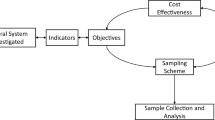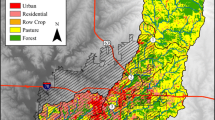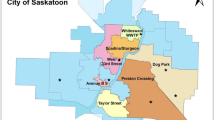Abstract
Accurate quantification of stormwater pollutant levels is essential for estimating overall contaminant discharge to receiving waters. Numerous sampling approaches exist that attempt to balance accuracy against the costs associated with the sampling method. This study employs a novel and practical approach of evaluating the accuracy of different stormwater monitoring methodologies using stormflows and constituent concentrations produced by a fully validated continuous simulation watershed model. A major advantage of using a watershed model to simulate pollutant concentrations is that a large number of storms representing a broad range of conditions can be applied in testing the various sampling approaches. Seventy-eight distinct methodologies were evaluated by “virtual samplings” of 166 simulated storms of varying size, intensity and duration, representing 14 years of storms in Ballona Creek near Los Angeles, California. The 78 methods can be grouped into four general strategies: volume-paced compositing, time-paced compositing, pollutograph sampling, and microsampling. The performances of each sampling strategy was evaluated by comparing the (1) median relative error between the virtually sampled and the true modeled event mean concentration (EMC) of each storm (accuracy), (2) median absolute deviation about the median or “MAD” of the relative error or (precision), and (3) the percentage of storms where sampling methods were within 10% of the true EMC (combined measures of accuracy and precision). Finally, costs associated with site setup, sampling, and laboratory analysis were estimated for each method. Pollutograph sampling consistently outperformed the other three methods both in terms of accuracy and precision, but was the most costly method evaluated. Time-paced sampling consistently underestimated while volume-paced sampling over estimated the storm EMCs. Microsampling performance approached that of pollutograph sampling at a substantial cost savings. The most efficient method for routine stormwater monitoring in terms of a balance between performance and cost was volume-paced microsampling, with variable sample pacing to ensure that the entirety of the storm was captured. Pollutograph sampling is recommended if the data are to be used for detailed analysis of runoff dynamics.
Similar content being viewed by others
References
Ackerman, D., & Schiff, K. (2003). Modeling stormwater mass emissions to the Southern California Bight. Journal of Environmental Engineers, 129(4), 308–317.
Ackerman, D., Schiff, K., & Weisberg, S. (2005). Evaluating HSPF in an arid, urbanized watershed. Journal of American Water Resource Association, 41(2), 477–486.
Ackerman, D., & Weisberg, S. (2003). Relationship between rainfall and beach bacterial concentrations on Santa Monica Bay beaches. Journal of Water and Health, 1, 85–89.
Ackerman, D., & Weisberg, S. B. (2006). Evaluating HSPF runoff and water quality predictions at multiple time and spatial scales. In S. B. W. a. K. Miller (Ed.), Southern California coastal water research project biennial report 2005–2006 (pp. 293–303). Westminster, CA: Southern California Coastal Water Research Project.
Bicknell, B. R., Imhoff, J. C., Kittle, J. L., Jr., Jobes, T. H., & Donigian, A. S., Jr. (2001). Hydrological simulation program—FORTRAN, version 12. Mountain View: AQUA TERRA Consultants.
Buffleben, M. S., Zayeed, K., Kimbrough, D., Stenstrom, M. K., & Suffet, I. H. (2002). Evaluation of urban non-point source runoff of hazardous metals entering Santa Monica Bay, California (pp. 263–268). I W a.
Daly, C., & Taylor, G. (1998). California average monthly or annual precipitation, 1961–90. http://www.ftw.nrcs.usda.gov/prism/prism.html, 1999.
Granato, G. E., Zenone, C., & Cazenas, P. A. (Eds.) (2002). National highway runoff water-quality data and methodology synthesis, Volume I—Technical issues for monitoring highway runoff and urban stormwater (p. 479). U.S. Geological Survey Technical Report FHWA-EP-02-007.
Hampel, F. R. (1974). The influence curve and its role in robust estimation. Journal of the American Statistical Association, 69, 383–393.
Harmel, R. D., Cooper, R. J., Slade, R. M., Haney, R. L., & Arnold, J. G. (2006). Cumulative uncertainty in measured streamflow and water quality data for small watersheds. Transactions of the American Society of Agricultural and Biological Engineers, 49(3), 689–701.
Harmel, R. D., King, K. W., & Slade, R. M. (2003). Automated storm water sampling on small watersheds. Applied Engineering in Agriculture, 19(6), 667–674.
Izuno, F. T., Rice, R. W., Garcia, R. M., Capone, L. T., & Downey, D. (1998). Time versus flow composite water sampling forregulatory purposes in the Everglades Agricultural Area. Applied Engineering in Agriculture, 14(3), 257–266.
King, K. W., & Harmel, R. D. (2003). Considerations in selecting a water quality sampling strategy. Transactions of the ASAE, 46(1), 63–73.
King, K. W., & Harmel, R. D. (2004). Comparison of time-based sampling strategies to determine nitrogen loading in plot-scale runoff. Transactions of the ASAE, 47(5), 1457–1463.
King, K. W., Harmel, R. D., & Fausey, L. (2005). Development and sensitivity of a method to select time- and flow-paced storm event sampling intervals for headwater streams. Journal of Soil And Water Conservation, 60(6), 323–331.
Leecaster, M., Schiff, K., & Tiefenthaler, L. (2002). Assessment of efficient sampling designs for urban stormwater monitoring. Water Research, 36, 1556–1564.
Los Angeles County Department of Public Works (2003). Data files. Alhambra: Los Angeles County Department of Public Works.
Ma, J. A., Kang, J. H., Kayhanian, M., & Stenstrom, M. K. (2009). Sampling issues in urban runoff monitoring programs: Composite versus grab. Journal of Environmental Engineering, 135(3), 118–127.
NCDC (2004). Hourly meteorological data. http://lwf.ncdc.noaa.gov/oa/ncdc.html, 2001.
Richards, R. P., & Holloway, J. (1987). Monte Carlo studies of sampling strategies for estimating tributary loads. Water Resources Research, 23(10), 1939–1948.
Robertson, D. M., & Roerish, E. D. (1999). Influence of various water quality sampling strategies on load estimates for small streams. Water Resources Research, 35(12), 3747–3759.
Shih, G., Abtew, W., & Obeysekera, J. (1994). Accuracy of nutrient runoff load calculations using time-composite sampling. Transactions of ASAE, 37(2), 419–429.
Southern California Association of Governments (2004). 2000 Los Angeles County land use.
Stein, E. D., Tiefenthaler, L., & Schiff, K. (2005). Watershed-based sources of polycyclic aromatic hydrocarbons in urban storm water. Environmental Toxicology and Chemistry, 25(2), 373–385.
Stone, K. C., Hunt, P. G., Novak, J. M., Johnson, M. H., & Watts, D. W. (2000). Flow-proportional, time-composited, and grab sample estimation of nitrogen export from an Eastern Coastal Plain watershed. Transactions of ASAE, 43(2), 281–290.
Tiefenthaler, L., Schiff, K., & Leecaster, M. (2001). Temporal variability patterns of stormwater concentrations in urban stormwater runoff. In S. B. Weisberg, & D. Hallock (Eds.), Southern California coastal water research project annual report 2000 (pp. 28–44). Westminster: Southern California Coastal Water Research Project.
Tiefenthaler, L. L., Stein, E. D., & Schiff, K. C. (2008). Watershed and land use-based sources of trace metals in urban storm water. Environmental Toxicology and Chemistry, 27(2), 277–287.
Author information
Authors and Affiliations
Corresponding author
Rights and permissions
About this article
Cite this article
Ackerman, D., Stein, E.D. & Ritter, K.J. Evaluating performance of stormwater sampling approaches using a dynamic watershed model. Environ Monit Assess 180, 283–302 (2011). https://doi.org/10.1007/s10661-010-1788-6
Received:
Accepted:
Published:
Issue Date:
DOI: https://doi.org/10.1007/s10661-010-1788-6




